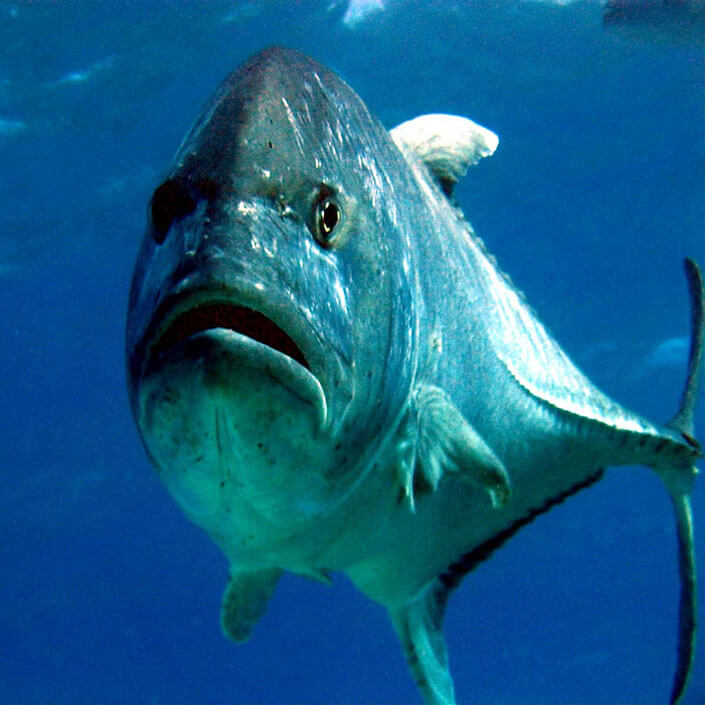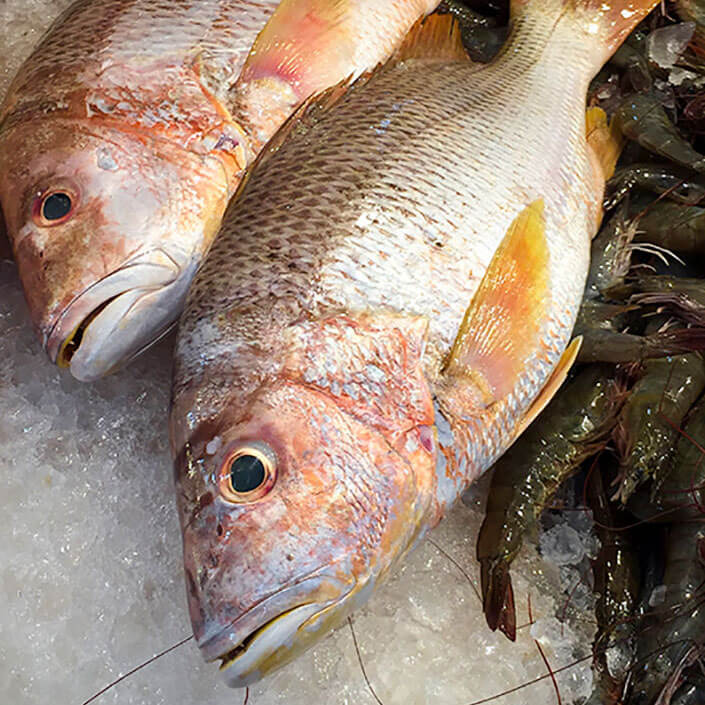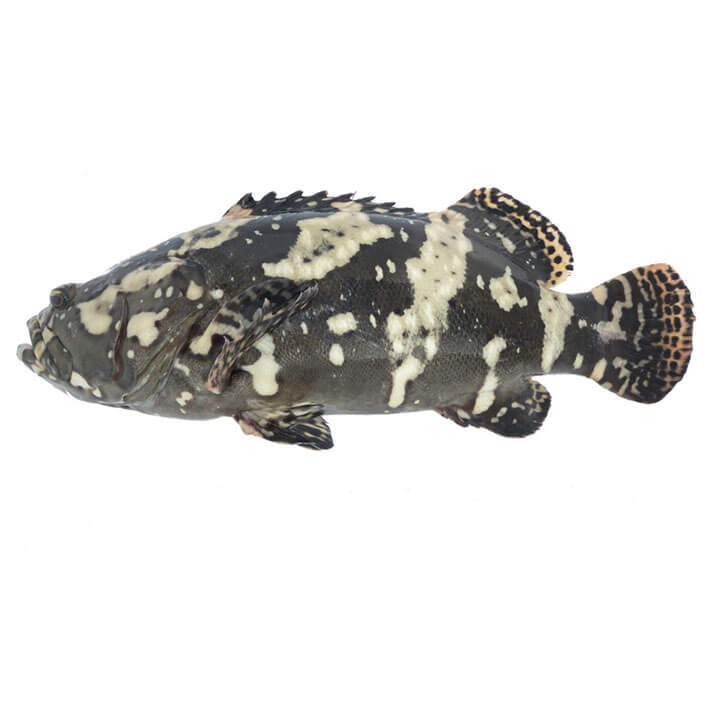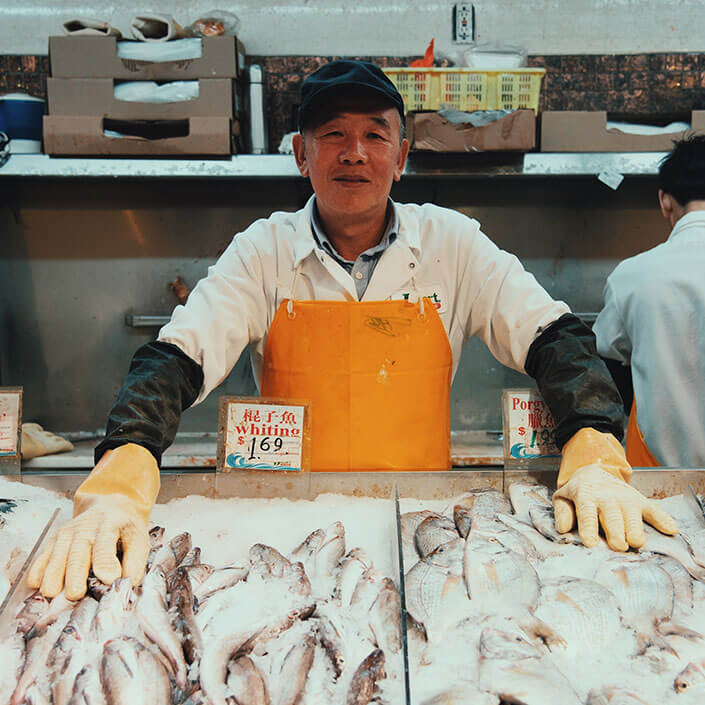Our Fish
LIVE FISH

Giant Trevally
The giant trevally, Caranx ignobilis (also known as the lowly trevally, barrier trevally, giant kingfish, or ulua), is a species of large marine fish classified in the jack family, Carangidae. The giant trevally is distributed throughout the tropical waters of the Indo-Pacific region, with a range stretching from South Africa in the west to Hawaii in the east, including Japan in the north and Australia in the south. Two were documented in the eastern tropical Pacific in the 2010s (one captured off Panama and another sighted at the Galápagos), but it remains to be seen if the species will become established there.
The giant trevally’s early larval stages and their behaviour have been extensively described, with all fins having formed by at least 8 mm in length, with larvae and subjuveniles being silver with six dark vertical bars. Laboratory populations of fish show a significant variability in the length at a certain age, with the average range being around 6.5 mm. Growth rates in larvae between 8.0 and 16.5 mm are on average 0.36 mm per day. The speed at which larvae swim increases with age from 12 cm/s at 8 mm in length to 40 cm/s at 16.5 mm, with size rather than age a better predictor of this parameter.
Read more
Barramundi
The barramundi or Asian sea bass (Lates calcarifer) is a species of catadromous fish in family Latidae of order Perciformes. The species is widely distributed in the Indo-West Pacific region from Southeast Asia to Papua New Guinea and Northern Australia. Known in Thai language as pla kapong, it is very popular in Thai cuisine. Barramundi is a loanword from an Australian Aboriginal language of the Rockhampton area in Queensland meaning «large-scaled river fish». Originally, the name barramundi referred to saratoga and Gulf saratoga. However, the name was appropriated for marketing reasons during the 1980s, a decision which has aided in raising the profile of this fish significantly. L. calcarifer is broadly referred to as Asian seabass by the international scientific community, but is also known as Australian seabass.
The fish is of commercial importance; it is fished internationally and raised in aquaculture in Australia, Saudi Arabia, Malaysia, India, Indonesia, Vietnam, Israel, Thailand, the United States, Poland, and the U.K. The barramundi industry is relatively established.
Read more
Golden Snapper
Lutjanus johnii, commonly known as John’s snapper or golden snapper, is a marine fish native to the western Pacific and Indian Oceans, from East Africa to Fiji and Australia. In Queensland, Northern Territory and other parts of Australia it is perhaps known more commonly as Fingermark bream, and is arguably one of the best estuary eating fish. The former name (‘Golden snapper’) is generally used when the fish is in much larger sizes, with juveniles and young adults usually referred to as the latter (‘Fingermark’). It has a remarkably slow growth rate, so release is encouraged and bag limits apply. It can grow to approximately 8 kg in weight although 10 kg fish have been recorded off the coast of Cairns, though even a small individual will provide a substantial fight.
Fingermark encounters often occur when targeting other species such as barramundi, and can be distinguished by their golden-brown to reddish skin tint and dark ‘fingermark’ beneath the dorsal fin – colourations both lost as the species dies once taken from the water or grows in size. Colourations are extremely prominent in juvenile fish. They are members of the Lutjanus genus of snappers, which also includes mangrove jack and other well-known table species.
Read more
Red Snapper
The Mangrove red snapper (commonly called mangrove jack within Australia), Lutjanus argentimaculatus is a species of snapper. It is also known as creek red bream, the Stuart evader, dog bream, mangrove red snapper, purple sea perch, purple sea-perch, red bass, red bream, red perch, red reef bream, river roman or rock barramundi.
Coloration of the mangrove red snapper ranges from burnt orange, to copper, to bronze and dark reddish-brown, depending on its age and environment. Younger fish caught in estuarine areas are often darker than older fish taken from offshore reef areas, and exhibit lighter vertical bands down their flanks. In reef areas, mangrove red snappers are sometimes confused with two-spot red snapper or red bass (Lutjanus bohar), a known carrier of ciguatera toxin. The red bass, however, is usually darker in coloration, has fewer dorsal-fin spines, scale rows on the back that rise obliquely from the lateral line, and a deep groove from the nostrils to the eyes. Mangrove red snapper is a popular and important commercial and recreational fish throughout its range, and considered to be an excellent food fish. The mangrove red snapper is a highly regarded table fish with firm, sweet-tasting, white flesh.
Read more
Orange-Spotted Grouper
The orange-spotted grouper (Epinephelus coioides), also known as the estuary cod, estuary rockcod, estuary rock-cod, green grouper is a species of fish in the family Serranidae. It is found in the western Pacific, the Indian Ocean, and the Red Sea. It has also been recorded in the Mediterranean Sea as a Lessepsian migrant. Orange-spotted grouper is an economically important marine fish cultured Southeast Asian countries.
Orange-spotted groupers begin life as a female, reaching sexual maturity at around 2 to 3 years old, when 25 to 30 centimetres in length. When the female reaches around 55 to 75 centimetres, at approximately four years old, it changes sex and becomes a male.
Its natural habitats are subtropical or tropical mangrove, open seas, shallow seas, subtidal aquatic beds, coral reefs, estuarine waters, intertidal flats, and coastal saline lagoons. It is threatened by habitat loss and overfishing. This predatory fish reaches up to 1.2 m (3.9 ft) in length.
Read more
Hybrid Grouper
Hybrid grouper is a new type of grouper. The first hybrid grouper is cross-bred by researches from Universiti Malaysia Sabah (UMS), Malaysia, in collaboration among researchers of the Borneo Marine Research Institute of UMS, the Fisheries Development Authority of Malaysia (LKIM) and Kinki University of Japan, represented by Prof. Dr Shigeharu Senoo of UMS.
This kind of grouper that not only matures faster, but is also able to withstand the vagaries of environmental conditions. The hybrid grouper was a major breakthrough because the species could withstand fluctuations in environmental conditions caused by climate change. Hybrid grouper reached maturity in about 8 months, which was about forty percents faster than its non-hybrid parents. Hybrid grouper was produced by fertilising the eggs of the tiger grouper (Epinephelus fuscoguttatus) with the sperm of the giant grouper (Epinephelus lanceolatus) through the in-vitro fertilisation (IVF) technique.
Read more

Other products
Chilled Fish
We provide different options for our customers on the type of the finished product. Regardless of whether it is live, chilled, frozen or fish fillet, Fishance makes sure that customer will get the freshies batch possible, due to our optimized harvesting techniques, employees training and improved logistic services.

Other products
Fish fillet
text texttext texttext texttext texttext texttext texttext texttext texttext texttext texttext texttext texttext texttext texttext texttext texttext texttext texttext texttext texttext texttext texttext texttext texttext texttext texttext texttext texttext texttext texttext texttext texttext texttext texttext texttext texttext texttext texttext texttext texttext texttext texttext text
